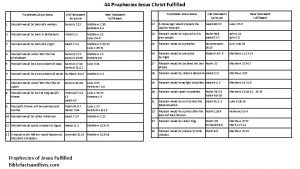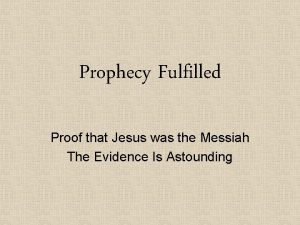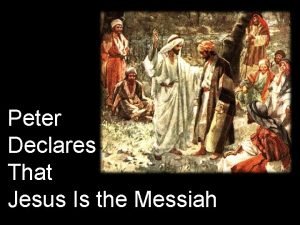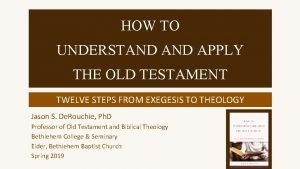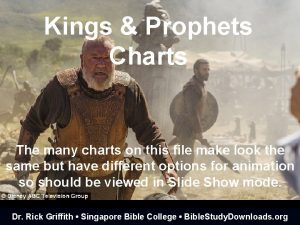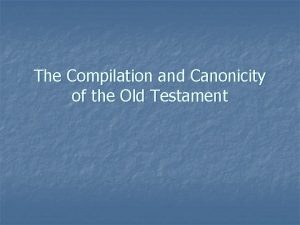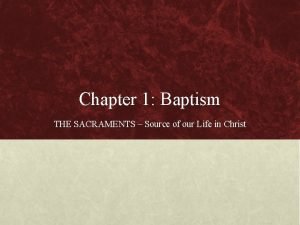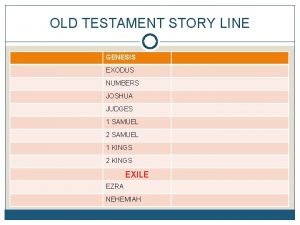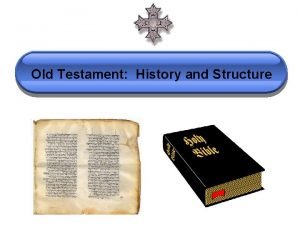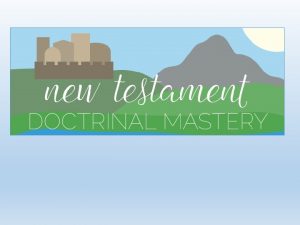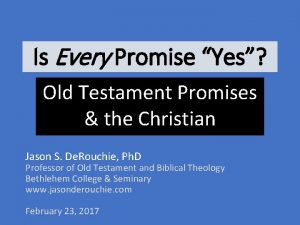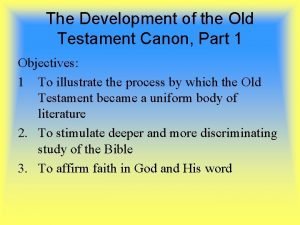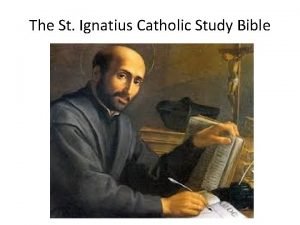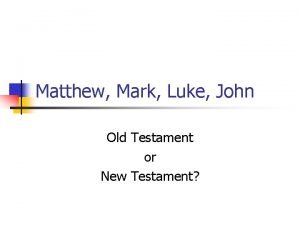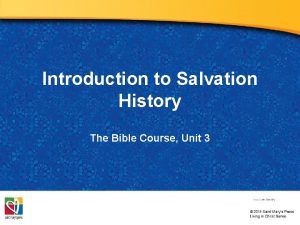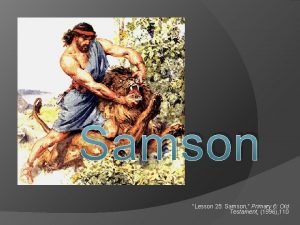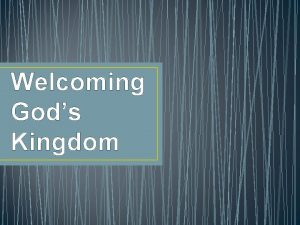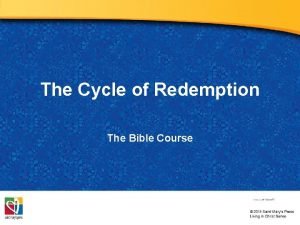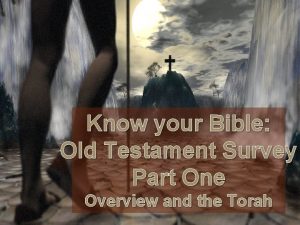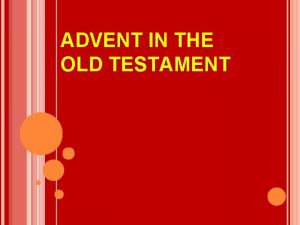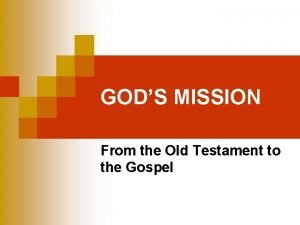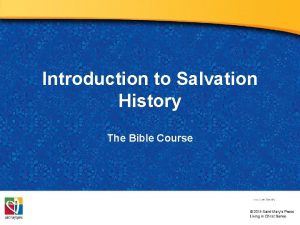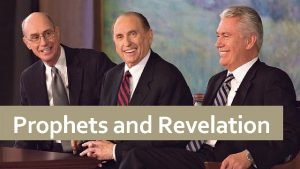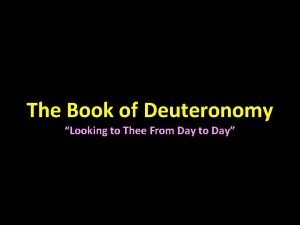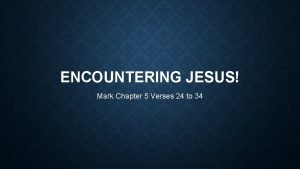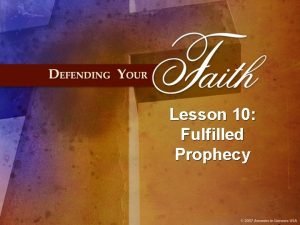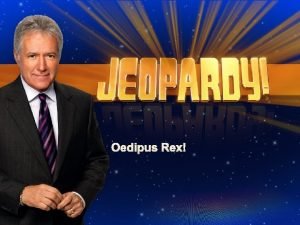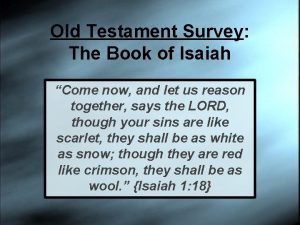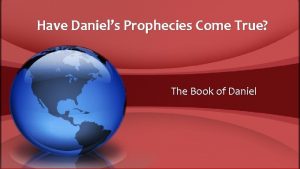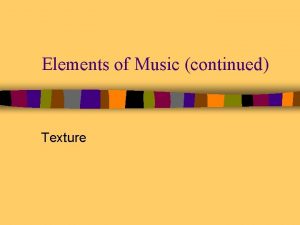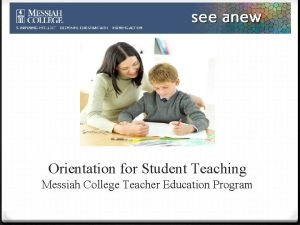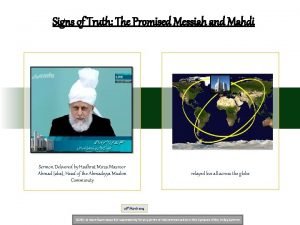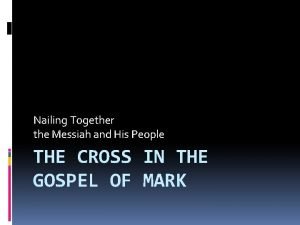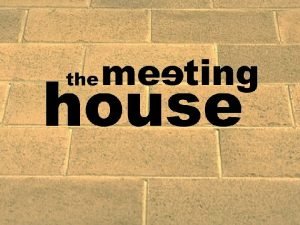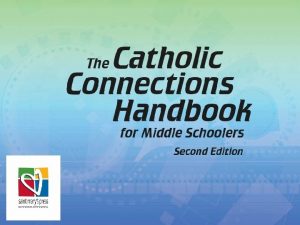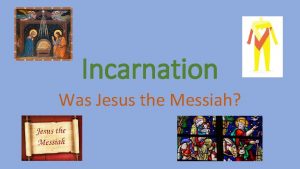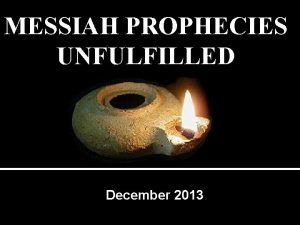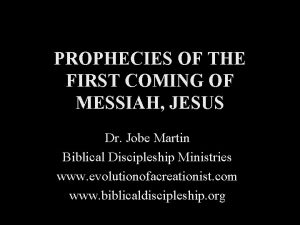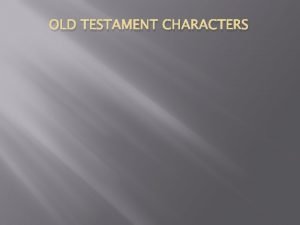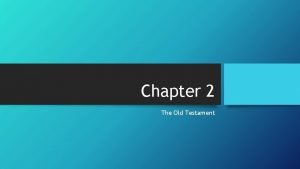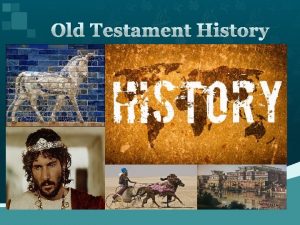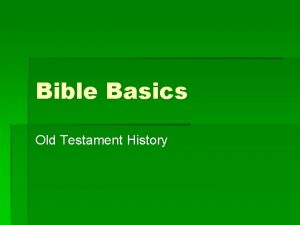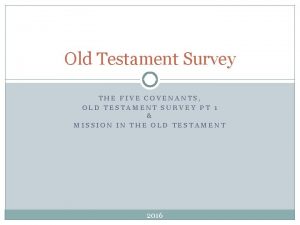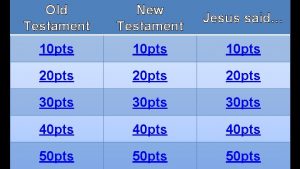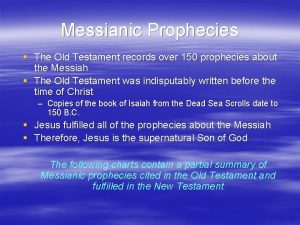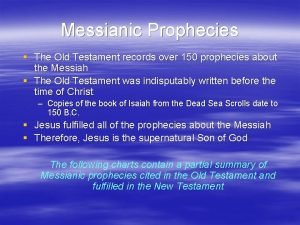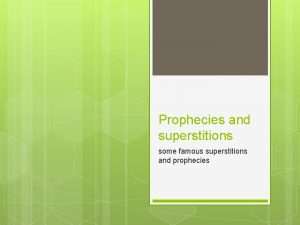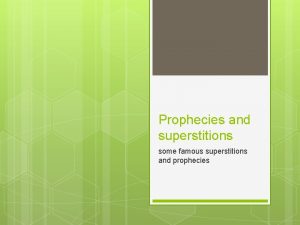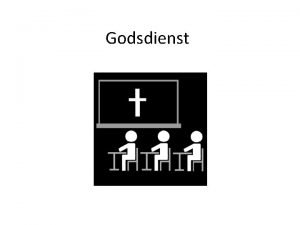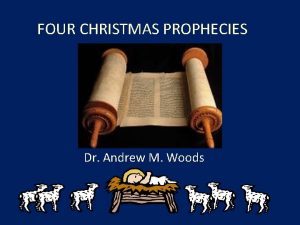WHO IS JESUS THE MESSIAH OLD TESTAMENT PROPHECIES
















































- Slides: 48

WHO IS JESUS THE MESSIAH?

OLD TESTAMENT PROPHECIES � Genealogical requirements �A descendent of Abraham – Gn. 12: 1 -3 � From the tribe of Judah – Gn. 49: 8 -10 � From the family of Jesse (David) – Is: 11: 1 � Reign on David’s throne – 2 Sm. 7: 16; Is. 9: 7 � The prophetic strand � Born in Bethlehem – Mi. 5: 2 � Born of a virgin – Is. 7: 14 � Called back from Egypt – Hos. 11: 1 � Physical � Humility evidence – Is. 42: 2, 3 � Suffering – Is. 53: 4 -7

JESUS IN JEWISH CONTEXT � The Synagogue � The word means “gathering place” or “ coming together” � At least 10 adult males required to have a synagogue � Supervised by a body of elders who named a layman be “ruler of the synagogue” � Contained an “ark” in which biblical scrolls were kept, seating, and a platform � The Sanhedrin � The Jewish high court � The high priest presided over seventy members � Rulings were limited to matters of religion




THE NATURE OF THE GOSPELS

THE SYNOPTIC QUESTION � Gospels – from the Greek word euaggelion meaning “good news” �A document that proclaims Jesus as the promised Messiah � Not “ biographies” in the modern sense, but proclamations � Synoptic – “to look together” � Four gospels; four views of Jesus � Three of the four are similar � The synoptic question: � Why are there three gospels that record the events in the life of Jesus in much the same way, but with individual differences between the three?

SIMILARITIES/DISSIMILARITIES � Similarities � Agreement in the selection of materials � Similar wording � Agreement in the general chronology Period of preparation Ministry in Galilee Ministry on the way to Jerusalem Final days – trial, death, resurrection � Dissimilarities � Each gospel has material peculiar to it alone � Differences in parallel accounts � Some episodes are transposed and in different context

QUESTIONS ABOUT FASTING � Matthew 9: 14 -15 Then John's disciples came and asked him, "How is it that we and the Pharisees fast, but your disciples do not fast? " 15 Jesus answered, "How can the guests of the bridegroom mourn while he is with them? The time will come when the bridegroom will be taken from them; then they will fast. � Mark 2: 18 -19 Now John's disciples and the Pharisees were fasting. Some people came and asked Jesus, "How is it that John's disciples and the disciples of the Pharisees are fasting, but yours are not? " 19 Jesus answered, "How can the guests of the bridegroom fast while he is with them? They cannot, so long as they have him with them. 20 But the time will come when the bridegroom will be taken from them, and on that day they will fast. � Luke 5: 33 -35 They said to him, "John's disciples often fast and pray, and so do the disciples of the Pharisees, but yours go on eating and drinking. " 34 Jesus answered, "Can you make the guests of the bridegroom fast while he is with them? 35 But the time will come when the bridegroom will be taken from them; in

THE TEMPTATION � Matthew 4: 1 -4 Then Jesus was led by the Spirit into the desert to be tempted by the devil. After fasting forty days and forty nights, he was hungry. The tempter came to him and said, "If you are the Son of God, tell these stones to become bread. “ Jesus answered, "It is written: 'Man does not live on bread alone, but on every word that comes from the mouth of God. '“. . . 11 Then the devil left him, and angels came and attended him. � Mark 1: 12 -13 At once the Spirit sent him out into the desert, and he was in the desert forty days, being tempted by Satan. He was with the wild animals, and angels attended him.

PRINCIPLE SYNOPTIC THEORIES �Aramaic Ur �Fragmentary �Oral tradition �Mutual interdependence (Two gospel theory) �Two document hypothesis �Four document hypothesis (See Study Guide, p. 188)

GRIESBACH HYPOTHESIS (Two Gospel Theory) Matthean priority Marcan priority


FOUR-SOURCE THEORY

THE ORIGIN OF THE GOSPELS � Mathew � The church fathers dated Mathew’s first � Tradition placed Mathew in Persia when he wrote � Wrote in Aramaic (? ) then translated into Greek � Luke � Wrote the Gospel before Acts probably during Paul’s Roman imprisonment (59 -61 CE) � Mark � Recorded Peter’s testimony near time of his death (64 CE) � John � Written about 90 CE when few eyewitnesses remained alive � Perhaps written in Ephesus

PRINCIPLE CHARACTERISTICS OF THE GOSPELS

MATTHEW �Written by a Jew (his Jewish name was Levi) �A tax collector for the Roman government (Mt. 9: 9) before becoming a disciple. �Principle characteristics: �Well structured work in form and style �May have originally been in Aramaic �Begins with a genealogy �Lacks clear statement of purpose but appears to be written to a primarily Jewish audience to show Jesus fulfilled OT messianic prophecies. �Written about 65 -71 CE (place unknown).

MARK Son of Mary of Jerusalem; also called John (Acts 12: 12) � Accompanied Paul and later Barnabas � Said to be the “memoirs” of Peter � Date (45 -70 CE? ) uncertain; written from Rome (? ) � Principle characteristic: � The shortest gospel � Written in a concise, vivid, “rough” style � Lacks a genealogy and birth narrative � Contains “action” narratives with little discourse (direct teachings) � Records few saying of Jesus � Written to appeal to a Gentile audience (Romans? ), showing the power of Jesus through his miracles � Portrays Jesus as “ Son of God”, “ Son of Man”, and “the Redeemer” � Two-thirds of his gospel is devoted to the passion of Christ � Some textual questions at the end of the gospel �

LUKE �A Gentile (? ) physician (Col. 4: 14) � Written before 64 CE from Caesarea (? ) � Principle characteristics: � The longest gospel written in a refined style � Most comprehensive treatment of the life of Jesus � Begins with a significant preface (1: 1 -4) � Written to Theophilus to explain the faith � Not an eyewitness; he researched everything carefully � Has a universal outlook, showing that Jesus was the savior of the world (See Lk. 2: 29 -32)

JOHN � John, the apostle, and brother James called the “sons of thunder” (Boanerges). � Among the first disciples; one of the “inner circle” � Written near the end of the apostle’s life (90 CE ? ) � Omits many details in favor of a more thorough explanation of the significance of Jesus’ ministry � Cites fewer miracles than the others � Centered around five Jewish festivals: 1 st Passover, unnamed feast, Tabernacles, Dedication, last Passover � Contains the clearest explanation of the purpose of the gospel (John 20: 30, 31) � Portrays Jesus as the “ I AM”, the “ Lamb of God”, The Bread of life”, “ the light”, the “true shepherd”

THE MINISTRY OF JESUS MESSIAH KEY EVENTS

THE BIRTH OF THE FORERUNNER �Gabriel announced the birth of John the Baptist to his parents Zechariah, a priest, and Elizabeth (Lc. 1: 5 -25) �Lived the life of a Nazarite (See Nu. 6) �Went out in “the spirit of Elijah”, that is, fulfilled the prophecies regarding the coming of the forerunner of the Messiah �Assumed a prophetic role, calling the nation to repentance

THE BIRTH OF THE MESSIAH The birth of John the Baptist (Baptizer) � Announced by Gabriel to Mary “pledged to be married to Joseph” � � � More than just a type of “engagement” Could be terminated by a formal “divorce” Appeared to Joseph to reassure him � Journey to Bethlehem � Required for a census � Places the birth of Jesus about 6 -4 CE � Birth announced to shepherds � Dedication at the Temple in Jerusalem � The magi (Matt. 2: 1 -12) � Part of an oriental guild of astrologers � Uncertain how many � The flight to Egypt (Matt. 2: 13 -19) � Herod ordered the murder of all male children two and under � The family fled to Egypt and retuned only after Herod’s death �



WHEN WAS JESUS BORN? � Originally thought by a certain Dionysius Exiguus to coincide with 1 CE (AD) � However, we know that Herod the Great died in 4 BCE so Jesus would have been born in or before that year (See Matt. 2: 19) � According to Lk. 2: 8, shepherds were “in the fields” the night of his birth, suggesting a time not in the winter which would make traveling difficult � Some suggest that September would be more likely. � Dec 25 became the day that his birth is celebrated in the 4 th cent. CE which corresponded to a Roman sun festival.

THE PREEXISTING CHRIST �John’s gospel speaks of Christ’s preexistence. (John 1: 1) �Uses a descriptive Greek word: Logos �Most often translated “word” �Implications: � To the Jew, the Logos referred to the God of creation and revelation. � God’s communication of wisdom to His people. � implies the self-expression of God's thoughts � John applies it to Jesus Christ who is from “the beginning”, that is, as far back as one can conceive.

JESUS’ EARLY LIFE � Luke is the only gospel writer that spoke of Jesus’ early life. (Luke 2: 39 -52) � Subject to his parents in his formative years. � Presumably took over the “family business” when Joseph died. � Luke’s words in 2: 52 are descriptive. Jesus � Increased in wisdom (intellectual development) � Increased in stature (physical development) � Increased in favor with God (spiritual development) � Increased in favor with others (social development)

THE MESSAGE OF THE MESSIAH

THE MESSAGE OF THE MESSIAH � Baptism � and Temptation (Matt. 3: 13 -4: 17; Mk. 1: 9 -12) Baptized by John to: � “Fulfill all righteousness” � As a confirmation of his divine origin Tempted by Satan – tempted to abuse his power and reject his trust in the Father � Served to show that victory over temptation is possible � � Early Judean ministry (John 1: 29 -51) Returned to the Jordan region after the temptation � Called his first disciples – Andrew, John, Andrew, Peter (Cephas), Philip and Nathanael � � Galilean ministry begins Began preaching and healing ministry centered in Capernaum � First miracle – wedding at Cana (John 2: 1 -11) � Journeys to Jerusalem � � Passover � Cleansing of the Temple (John 2: 12 -25) � Nicodemus and trip through Samaria (John 3 -4)

JESUS AND NICODEMUS (John 3: 1 -21) 3: 1 -21 �A member of the Sanhedrin, the Jewish High Court � Sought out Jesus “at night” � Seems to be a sincere Jewish leader who wanted to know more about the things that Jesus was teaching � Provides the backdrop for several remarkable declarations by Jesus about the nature of spiritual life � There are two births – physical and spiritual � Physical birth into a religious tradition is no guarantee of spiritual rebirth � There must be a faith commitment to the Son of God in order for true spiritual life to begin


JESUS AND THE SAMARITAN WOMAN (JOHN 4: 1 -42) � Returned to Galilee by way of Samaria � Avoided by Jews because of the animosity between Jews and Samaritans � Spoke with a woman who came to draw water � Revealed things about her personal life � Jesus reveals that he is the Messiah that she has been waiting for. � Several key lessons: � The breaking down of cultural and social barriers � The need for spiritual “water” � The nature of true worship

THE GALILEAN MINISTRY

JESUS’ GALILEAN MINISTRY � The longest single period of public ministry � “Worked” primarily out of the city of Capernaum because he was not welcomed in Nazareth � His message is summarized by Mark: “After John was put in prison, Jesus went into Galilee, proclaiming the good news of God. ‘The time has come, ’ he said. ‘The kingdom of God is near. Repent and believe the good news!’” (Mark 1: 14 -15) � Three actions characterized Jesus’ ministry in Galilee: � Teaching in the synagogues � Preaching the good news of the gospel � Healing the sick and afflicted



MINISTRY IN NAZARETH AND CAPERNAUM � In Nazareth Asked to read from Isaiah in the synagogue (Lk. 4: 16) � Proclaimed the fulfillment of the prophecy � Expelled from the city � � In Capernaum Healed a paralytic after forgiving his sins � Demonstrated his power to forgive sin by restoring the health of the paralytic � � The Call of Matthew (Mt. 9: 9 -13; Mk. 2: 13 -17; Lk. 5: 27 -32) A Jew and a “publican” (tax collector) who worked for Rome � Hated by the Jews for his work � Demonstrates the appeal of the gospel to the upper class �

THE SERMON ON THE MOUNT: Matthew 5 -7 � Delivered in Galilee � Casts Jesus as a new kind of “law-giver” in the style of Moses, but with a different theme � A résumé of the values of the Kingdom of God: � The “Beatitudes” – characteristics of citizens of the kingdom (5: 1 -12) � “You have heard it said” – a reinterpretation of the law � “And when. . . ” – a reinterpretation of certain religious practices, such as giving, praying, and fasting (6: 1 -18) � Life beyond anxiety (6: 19 -34) � Practical advice on kingdom living � The danger of judging others (7: 1 -5) � The danger of false beliefs (7: 13 -23)

MOUNT OF THE BEATITUDES



SABBATH CONTROVERSIES � The Jewish Sabbath began at sunset (6 pm) on Friday and lasted until sunset (6 pm) on Saturday. � Strict regulations dictated what could not be done. � Regimented the life of Jews and destroyed the original intent of the observance. (See Ex. 20: 6 -11) � Several “conflicts” about the Sabbath: A healing in Jerusalem (John 5: 1 -15) � Jesus is Lord of the Sabbath (Mt. 12: 1 -8; Mk. 2: 23 -28; Lk. 6: 15) � Healing on the Sabbath (Mt. 12: 9 -14; Mk. 3: 1 -6; Lk. 6: 6 -11) � � The church no longer observes the Sabbath and Sunday is not to be understood as the “Christian Sabbath”

� John the Baptist (Matt. 11: 1 -6) � Now in prison, has doubts about Jesus’ messiahship � Perhaps he expected a messiah who would overthrow the reigning empire � Sends disciples to ask Jesus if he is really the one � Jesus points to what he has done as proof � The unpardonable sin (Matt. 12: 22 -37) � The Pharisees accused Jesus of casting out demons using Satan’s power � His reply: “How can Satan cast out Satan? ” � Several views: �Israel’s national sin of rejecting the Messiah �Unbelief until death �Denying God’s work through His Spirit and attributing the work of God to Satan


THE USE OF PARABLES �Parable – an extended metaphor or simile; a story that draws a parallel between familiar incidents and spiritual truths. �Why Jesus used parables: � To attract attention � To simulate inquiry � To plant a seed for further thought � To personalize his message � So the insensitive would be hardened and sensitive would understand (See Matt. 13: 10 -13)

�By way of parables, Jesus taught: �The nature of the kingdom of God (Matt. 13; Mk. 4; Lk. 8) “A sower went out to sow. . . ” “The kingdom of heaven is like. . . ” �The correct understanding of the law (Mk. 2: 23 -28) �The nature of God’s love (Lk. 15) �The coming judgment and preparation for the coming of the kingdom (Matt. 25)
 44 prophecies jesus fulfilled
44 prophecies jesus fulfilled Proof jesus is the messiah
Proof jesus is the messiah Peter declares that jesus is the messiah reflection
Peter declares that jesus is the messiah reflection Jesus jesus jesus in the morning
Jesus jesus jesus in the morning Jesus jesus jesus sweetest name i know
Jesus jesus jesus sweetest name i know How to understand and apply the old testament
How to understand and apply the old testament Prophet, priest-king chart
Prophet, priest-king chart Old testament canon timeline
Old testament canon timeline How is baptism prefigured in the old testament
How is baptism prefigured in the old testament Old testament jewish temple layout
Old testament jewish temple layout Nehemiah timeline
Nehemiah timeline Doctrinal mastery scriptures old testament
Doctrinal mastery scriptures old testament Old testament promises
Old testament promises Rachel old testament
Rachel old testament Ot canon
Ot canon Luke 22:44
Luke 22:44 Ignatius catholic study bible
Ignatius catholic study bible Matthew mark luke john old testament
Matthew mark luke john old testament Titus in the bible summary
Titus in the bible summary What are the two pillars of divine revelation
What are the two pillars of divine revelation Samson lds
Samson lds Welcoming god's kingdom
Welcoming god's kingdom Books in old testament how many
Books in old testament how many What is the cycle of redemption
What is the cycle of redemption Where is havilah in the bible
Where is havilah in the bible Advent in the old testament
Advent in the old testament Mission in the old testament
Mission in the old testament Introduction of salvation history
Introduction of salvation history Doctrinal mastery prophets and revelation
Doctrinal mastery prophets and revelation Old testament festivals chart
Old testament festivals chart Encountering jesus in the new testament
Encountering jesus in the new testament Encountering jesus in the new testament answer key
Encountering jesus in the new testament answer key Encountering jesus in the new testament
Encountering jesus in the new testament The book of mormon another testament of jesus christ
The book of mormon another testament of jesus christ Messianic prophecies fulfilled in the infancy narratives
Messianic prophecies fulfilled in the infancy narratives Character macbeth key quotes
Character macbeth key quotes Summary of macbeth
Summary of macbeth Famous beam bridges
Famous beam bridges The delphic stone of prophecies
The delphic stone of prophecies Isaiah's prophecies
Isaiah's prophecies Prophecies about to come true
Prophecies about to come true Messiah hallelujah texture
Messiah hallelujah texture Messiah college canvas
Messiah college canvas Signs of the promised messiah
Signs of the promised messiah Stauros meaning
Stauros meaning Messiah the anointed one
Messiah the anointed one Messiah definiton
Messiah definiton How to put a unit number in an address
How to put a unit number in an address Messiah wanted poster
Messiah wanted poster
